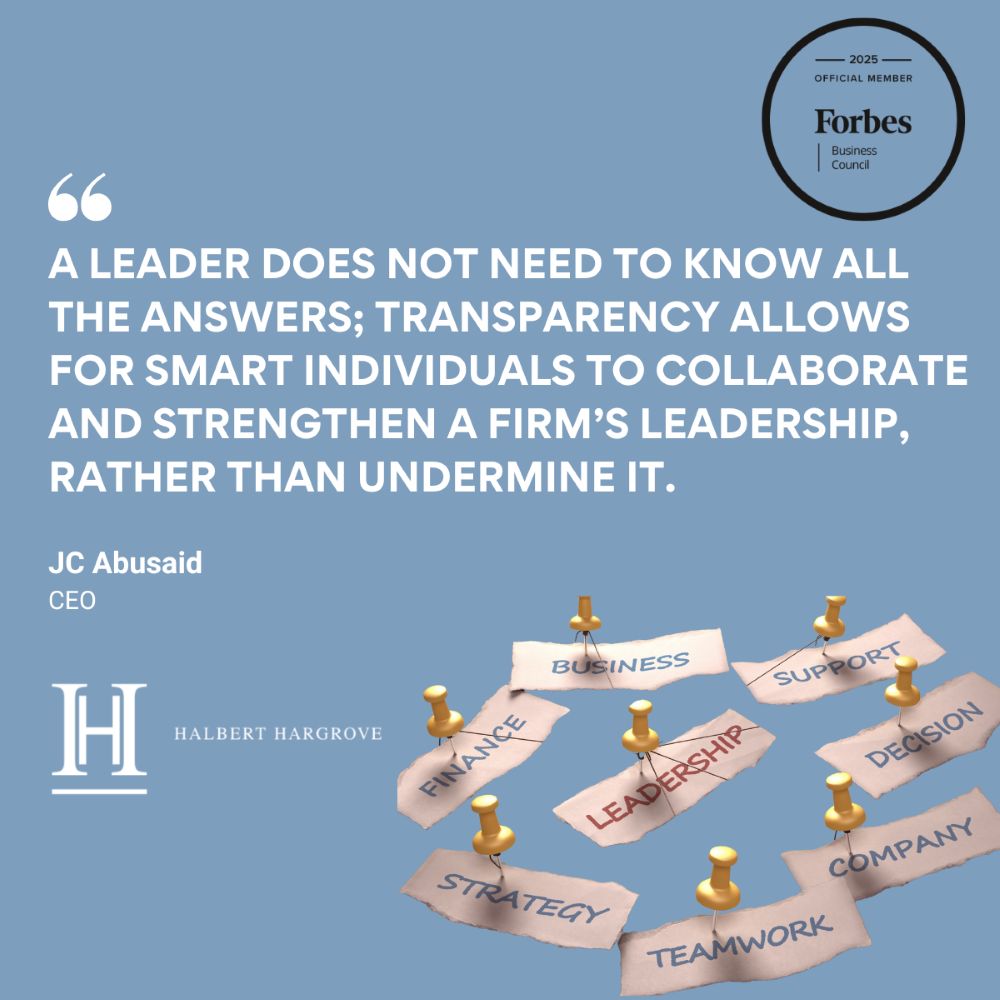By JC Abusaid, CEO/President
Transparency in leadership directly impacts employee engagement, trust and retention. Many studies consistently highlight the positive effects of open communication in workplaces. For example, a LeadershipIQ survey of more than 27,000 executives, managers and employees found that 63% of those employees in transparent organizations would strongly recommend their workplace, compared to just 6% in organizations with closed communication channels. Similarly, Deloitte’s 2024 Global Human Capital Trends report found that 86% of HR and business leaders across industries recognize a connection between leadership transparency and employee trust.
To effectively lead, employees need to know the reasoning behind decisions, because when people know the purpose of the tasks they are given, they are more likely to be enthusiastic and proactive in the workplace. Here’s what you need to know to embrace transparent leadership:
Defining Transparent Leadership
Transparent leadership is when managers give reasons for the choices they make and justify the thinking that went into those decisions. This open communication style can create a more trusting and cooperative culture. I’ve also noticed that it makes employees feel appreciated and linked with the mission of the company. However, there are misconceptions about this approach, like the belief that explaining your actions makes you look weak. What this approach actually does is make leaders vulnerable to criticism and other perspectives, which makes the decision-making process more sustainable. Thus, the leaders demonstrate they are able to modify their approaches and achieve the best result, which is good for the team and the leader.
The Benefits Of Transparent Leadership
In my experience, when leaders take time to explain the reasoning behind their decisions to their teams, the consequences are profound. It’s not just that employees do what they are told—they do it with a sense of ownership. The employees now understand the “why” behind their work and can see the possible outcomes if their performance is lacking.
I’ve also seen how this leadership style enhances productivity and motivation. When employees know what they are doing and how it contributes to the company’s overall goals, they are more likely to work harder. Employees feel more accountable to their teammates and the overarching goals.
In the case of a crisis, being forthcoming can help set expectations and proactively resolve certain issues that may come up down the line. I find it is helpful to call an all-hands-on-deck meeting to explain the situation, the possible consequences and the plan of action so that no one is left in the dark. This also provides employees with a forum to ask questions and voice their concerns.
How Leaders Can Implement Transparent Leadership
I recommend two strategies for incorporating more transparency into your organization:
Annual Strategic Meetings
Your leadership team should share the vision and major objectives for the new year once a year with the entire company. This meeting sets the tone for openness and ensures the entire company is on the same page.
Quarterly Updates
The company can check on the goals that were set during the annual strategic meeting during quarterly all-hands-on-deck meetings. The company will meet to discuss the accomplishments, explain the following steps, answer any questions and reemphasize goals and task assignments. This quarterly meeting will be very useful in helping the company maintain its focus on its missions and readjust its strategies if necessary.
These meetings help ensure that the entire company knows the goals and objectives, allow employees to see where their work is taking them and give them a chance to weigh in on whether a goal should be modified.
The Challenges Faced By Transparent Leaders
A transparent leadership style is not without its challenges. Take, for example, balancing transparency and discretion. I have found that while all information should be shared with your team, if it involves sensitive topics that could distract the team from its core missions, it may be beneficial to withhold that information temporarily.
Another problem is that transparency can significantly slow down decision-making because the team needs time to discuss and assess. Although it may stretch the decision-making process, I find it results in more thoughtful decisions. Nevertheless, this does not mean that all employees will agree with you when you practice transparent leadership. There are times when leaders cannot make every person on the team see the vision. Although this can be quite discouraging, it is inherent in leadership and develops integrity and the durability of trust.
Disagreements can often come from employees who dislike change or cannot see the whole picture. During a crisis, an employee was frustrated that their compensation levels were adjusted due to changes necessary to sustain the company. I was transparent about the challenges we faced, fostering open communication and ensuring they had a space to voice their concerns.
In closing, establishing transparency in your organization needs a systematic approach. I believe sharing your objectives and plans with your employees will drive them to work harder. Regular meetings provide the opportunity to maintain a connection with the company’s objectives and get honest and sincere opinions from employees.
A leader does not need to know all the answers; transparency allows for smart individuals to collaborate and strengthen a firm’s leadership, rather than undermine it. Ultimately, the best leaders are the ones who listen, create synergy and build consensus to take their teams to new heights.


